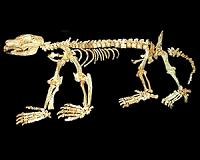 |
Washington DC (SPX) Jul 21, 2010 The first before-and-after view of an amphibian die-off has just been published by scientists working at the Smithsonian Tropical Research Institute in Panama. Like a wave, the fungal disease that wipes out frogs-chytridiomycosis-advances through the Central America highlands at a rate of about 30 kilometers per year. After the disappearance of Costa Rica's golden frogs in the 1980s, Karen Lips, associate professor at the University of Maryland, quickly established a monitoring program at untouched sites in neighboring Panama. Of the 63 species that she identified during surveys of Panama's Omar Torrijos National Park located in El Cope from 1998 to 2004, 25 species disappeared from the site in the subsequent epidemic. As of 2008, none of these species had reappeared there. Were there additional species in the park-"cryptic" diversity not previously known to science? To find out, the authors used a genetic technique called DNA barcoding to quickly estimate that another 11 unnamed or "candidate" species were also present. Combining the field and genetic information, the authors discovered that five of these unnamed species were also wiped out. "It's sadly ironic that we are discovering new species nearly as fast as we are losing them," said Andrew Crawford, former postdoctoral fellow at STRI and member of the Circulo Herpetologico de Panama, now at the University of the Andes in Colombia. "Our DNA barcode data reveal new species even at this relatively well-studied site, yet the field sampling shows that many of these species new to science are already gone here." An epidemic that wipes out a whole group of organisms is like the fire that burned the famous library of Alexandria. It destroys a huge amount of accumulated information about how life has coped with change in the past. Species surveys are like counting the number of different titles in the library, whereas a genetic survey is like counting the number of different words. "When you lose the words, you lose the potential to make new books," said Lips. "It's like the extinction of the dinosaurs. The areas where the disease has passed through are like graveyards; there's a void to be filled and we don't know what will happen as a result." "This is the first time that we've used genetic barcodes-DNA sequences unique to a given species-to characterize an entire amphibian community," said Eldredge Bermingham, STRI director and co-author. "STRI has also done barcoding on this scale for tropical trees on in our forest dynamics-monitoring plot in Panama. The before-and-after approach we took with the frogs tells us exactly what was lost to this deadly disease-33 percent of their evolutionary history."
Share This Article With Planet Earth
Related Links Smithsonian Tropical Research Institute Darwin Today At TerraDaily.com
 Remarkable Fossil Cave Shows How Ancient Marsupials Grew
Remarkable Fossil Cave Shows How Ancient Marsupials GrewSydney, Australia (SPX) Jul 20, 2010 The discovery of a remarkable 15-million-year-old Australian fossil limestone cave packed with even older animal bones has revealed almost the entire life cycle of a large prehistoric marsupial, from suckling young in the pouch still cutting their milk teeth to elderly adults. In an unprecedented find, a team of University of New South Wales [Sydney Australia] researchers in has unearthed ... read more |
|
| The content herein, unless otherwise known to be public domain, are Copyright 1995-2010 - SpaceDaily. AFP and UPI Wire Stories are copyright Agence France-Presse and United Press International. ESA Portal Reports are copyright European Space Agency. All NASA sourced material is public domain. Additional copyrights may apply in whole or part to other bona fide parties. Advertising does not imply endorsement,agreement or approval of any opinions, statements or information provided by SpaceDaily on any Web page published or hosted by SpaceDaily. Privacy Statement |